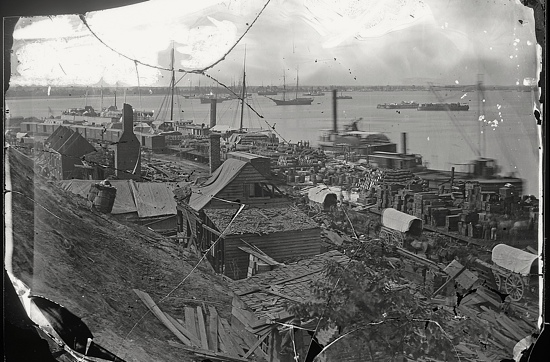Civil War: Sabotage at City Point
In the summer of 1864, the Confederate Secret Service launched a plot to attack City Point (present-day Hopewell).

It’s hard to get a sense of the scale of effort that went into the Union siege of Petersburg in 1864–at least until you learn that Gen. Ulysses S. Grant built an entire city just to support his siege efforts. Before Grant arrived, City Point (present-day Hopewell) was a quiet village at the intersection of the James and Appomattox rivers, and by the summer of 1864 it was a bustling harbor run by the Union army.
In addition to hundreds of ships transporting troops, supplies, and food, City Point featured a huge bakery that produced 100,000 bread rations per day. At any given time, City Point had enough food for 9,000,000 meals. By the time August rolled around, Union engineers had built railroad lines from City Point to the front lines at Petersburg and shipped 275 railroad cars via boat from Washington to operate between the two.
Meanwhile, on the other side of the trenches sat Robert E. Lee’s Confederate Army of Northern Virginia, stuck between Grant and the Confederate capital and strapped for both resources and reinforcements. When you compare the resources of the two opposing armies, it’s crazy to think the Petersburg siege lasted as long as it did. Given the resources at Grant’s disposal, victory at Petersburg was less an “if” and more a “when.” It made perfect sense for City Point to also serve as Grant’s headquarters during the Petersburg siege. He could closely monitor logistics and activity while keeping easy lines of communication both to the front lines and Washington. Abraham Lincoln even made two trips during the war to meet with Grant at City Point and review the operations there.
So it was only a matter of time before the Confederates would try to put a stop to the operations in City Point. However, with Lee’s army stuck firmly in the Petersburg trenches and with ironclads protecting City Point from the water, more “creative” approaches were required. In the summer of 1864, the Confederate Secret Service launched a plot to attack City Point.
Captain John Maxwell, a member of the Confederate Secret Service, left Richmond and met up with a local guide named R.K. Dillard. The two men snuck past Union pickets and talked their way past Union guards and, after a few days, successfully made their way into City Point. Maxwell carried a box containing 12 pounds of gunpowder and a timer built from parts of a clock–a 19th-century time bomb. Coincidentally, just a little over a week earlier, the Union army had used a bomb of its own to destroy Confederate earthworks at the Battle of the Crater outside Petersburg. This bombing plot, while it took place shortly after the battle, was well underway before that attack occurred and was not done in retaliation.
Maxwell’s time bomb wasn’t big enough to cause major damage on its own, so he needed to place it effectively. He chose a supply barge docked at the wharf located near several ammunition stores. He handed the box to an unknowing Union sentry and promptly retreated to a safe vantage point. An hour later, a huge explosion obliterated the barge and most of the wharf, sending debris and the bodies of soldiers flying into the air. 58 people were killed in the blast and another 126 were wounded. Gen. Grant and his aide Horace Porter were near the scene of the explosion. Horace later recalled “…there rained down upon the party a terrific shower of shells, bullets, boards, and fragments of timber. The general was surrounded by splinters and various kinds of ammunition, but fortunately was not touched by any of the missiles.” Even from their “safe” vantage point, Maxwell would later report that his local guide Dillard was permanently deafened by the blast.
In the immediate aftermath, Grant, unaware that the explosion was part of a Confederate plot, quickly sent a telegram north to Washington:
Five minutes ago an ordnance boat exploded, carrying lumber, grape, canister, and all kinds of shot over this point. Every part of the yard used as my headquarters is filled with splinters and fragments of shell. I do not know yet what the casualties are beyond my own headquarters. Colonel Babcock is slightly wounded in hand and 1 mounted orderly is killed and 2 or 3 wounded and several horses killed. The damage at the wharf must be considerable in both life and property. As soon as the smoke clears away I will ascertain and telegraph you.
The damage, while considerable, could not put a stop to the Union war machine at City Point. Just nine days after the devastating explosion, the wharf was fully repaired and shipping resumed as normal. City Point would remain Grant’s headquarters until the end of the war and the Confederates would not attack or disrupt operations there again.
Related
-
Recommend this
on Facebook -

Report an error
-

Subscribe to our
Weekly Digest




There are 3 reader comments. Read them.